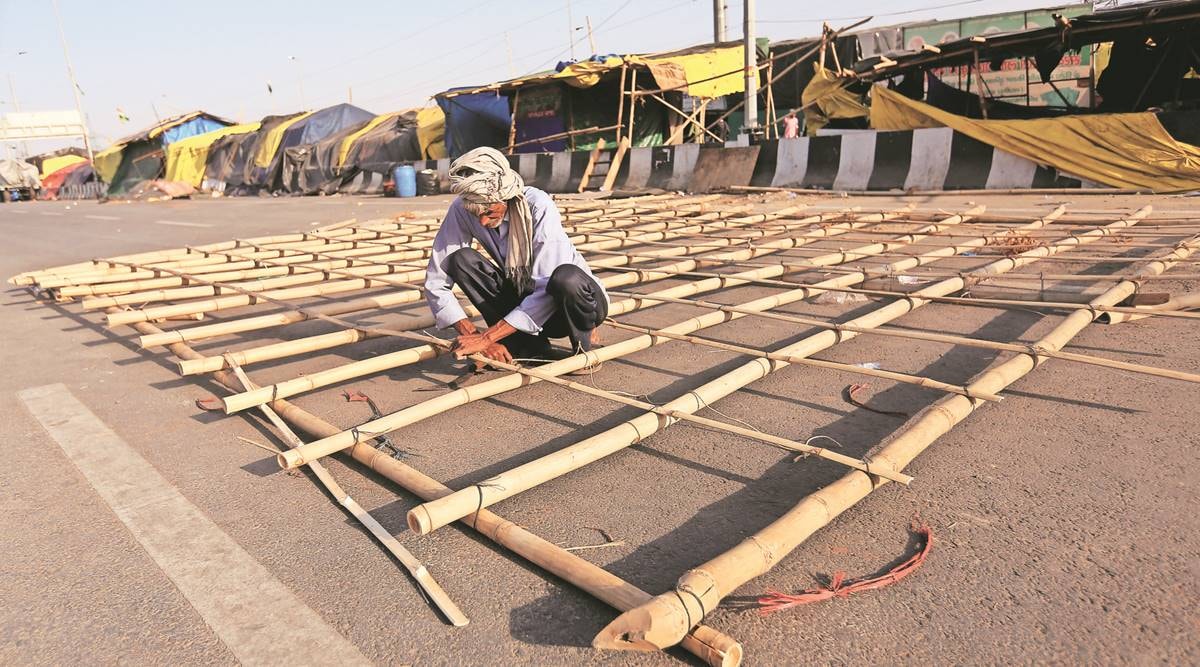 Farmers making bamboo house at Ghazipur border (Express Photo by Gajendra Yadav)
Farmers making bamboo house at Ghazipur border (Express Photo by Gajendra Yadav) Fewer tractor-trolleys, fewer people and a mushrooming of ‘sheds’ — the farmers’ protest at Singhu border is looking a little different during the ongoing wheat harvesting season.
On Saturday morning, Gurjeet Singh from Raily village in Punjab’s Fatehgarh Sahib district was overseeing the setting up of a bamboo shed on the highway currently being blockaded by the farmers’ protest at Singhu border. A group of three workers from Sonipat were building the 10×12 foot shed with materials also brought from Sonipat.
“We will put mattresses on the floor so 10 people will be able to sleep in it, a cooler and some light fittings for comfort. Once it is completed, women who come from our village will also be able to sleep comfortably,” he said.
The site on which the shed is being built used to be occupied by one of the five trolleys that his village used to have at the border. With the onset of the harvest season, three of these have returned to the village to be put to work.
Through the winter and most of the duration of this protest, farmers have mostly slept and lived in tractor-trolleys which they had brought from their villages. Now that they are needed for harvesting work, most villages have retained only one trolley at the protest site and the new ubiquitous sight at Singhu border is sheds made of bamboo and shade net. These sheds are also cooler than the trolleys.
The farmers of Behrampur Zimidara in Punjab’s Ropar district had built a shed two weeks ago, complete with a straw roof, curtains, potted plants and pictures of Bhagat Singh. “One of our two trolleys is back in the village for harvesting, and this is more comfortable. It doesn’t get heated up like the iron and tarpaulin of the trolleys,” said Gurmeet Singh from the village.
There are also fewer people at the site, but with the expectation that the numbers will be back in May after the end of the harvesting season. Rajvinder Singh from Ludhiana district’s Jatana village said even though the numbers are relatively less than usual, there are still around 10 protesters from each village present at the site at a given time.
“For a long time, the protest has followed a roster system of 10 farmers at a time coming from a village for a week or 10 days. Earlier, from our village, 20-30 people would come at a time. In about 10 days, the wheat harvesting work will be completed, and in a few more days, the bhusa for cattle feed will be prepared after which people will be completely free for two months until it is time to sow wheat in June,” he said.
Rajvinder is among three people from his village who are pakka members of the protest, meaning that they do not come and go like the others and have been stationed there continuously since November-end.
“Our sarpanch has said that our farm work will be done for us —for free — before other households,” he said.
- The Indian Express website has been rated GREEN for its credibility and trustworthiness by Newsguard, a global service that rates news sources for their journalistic standards.

